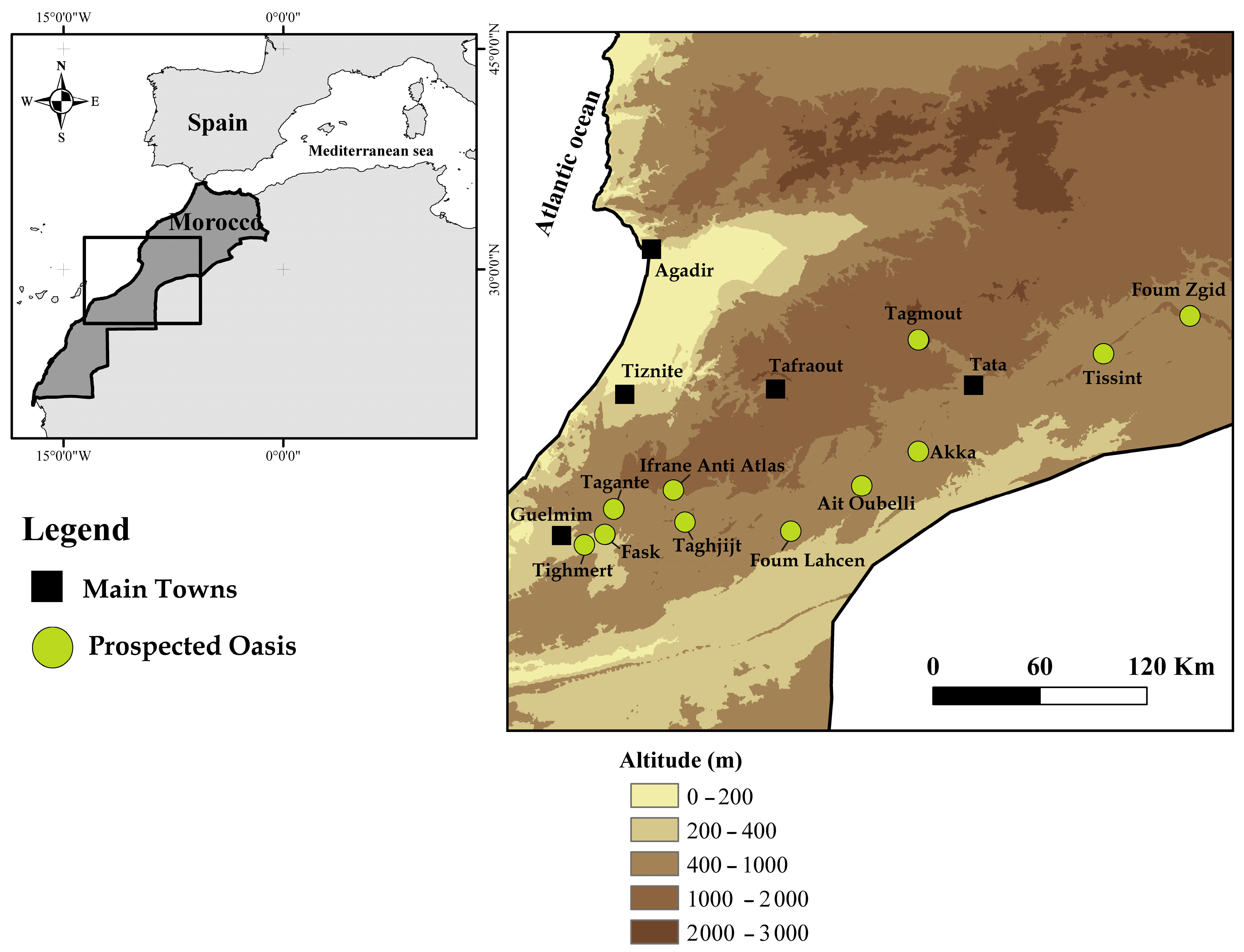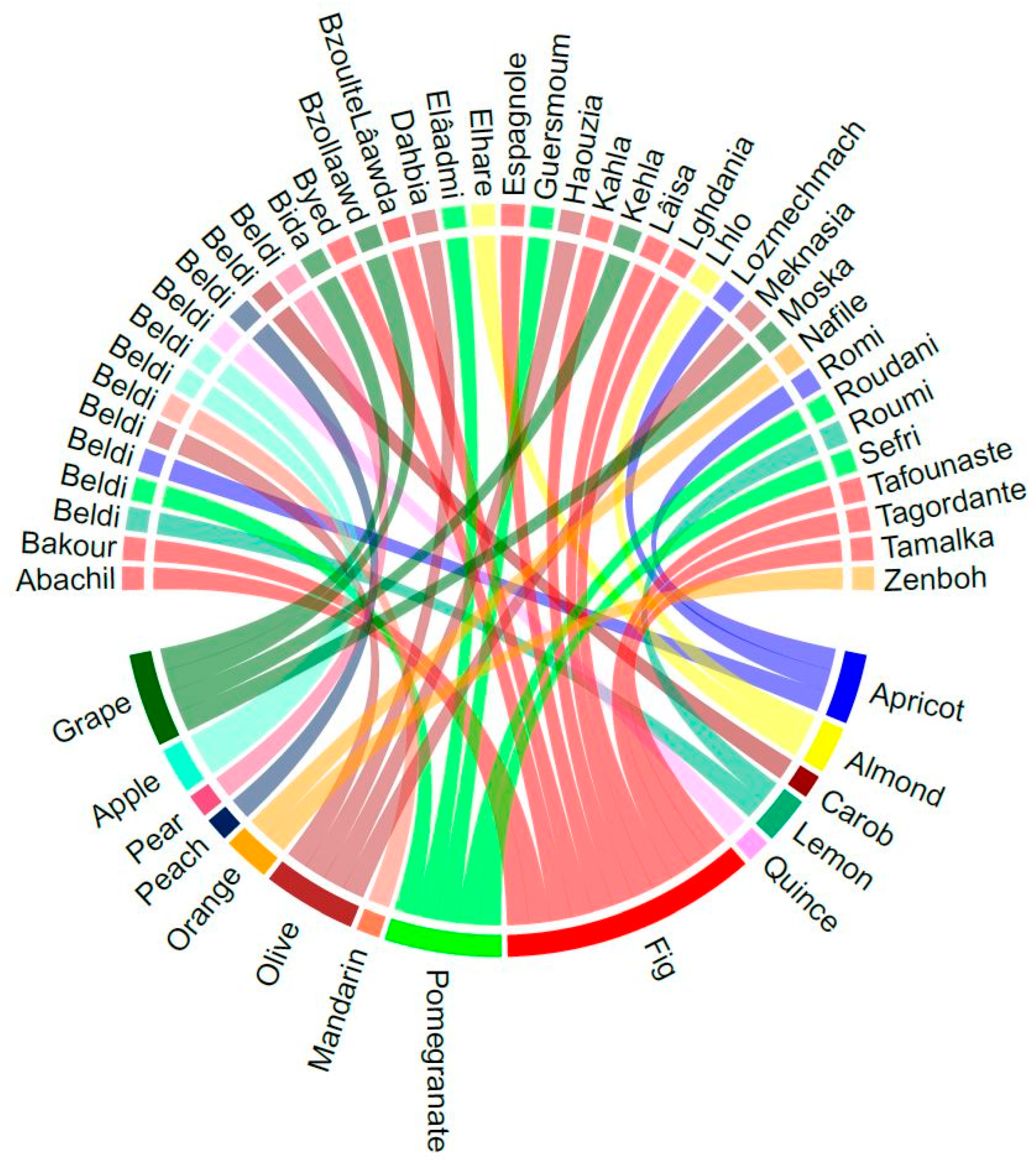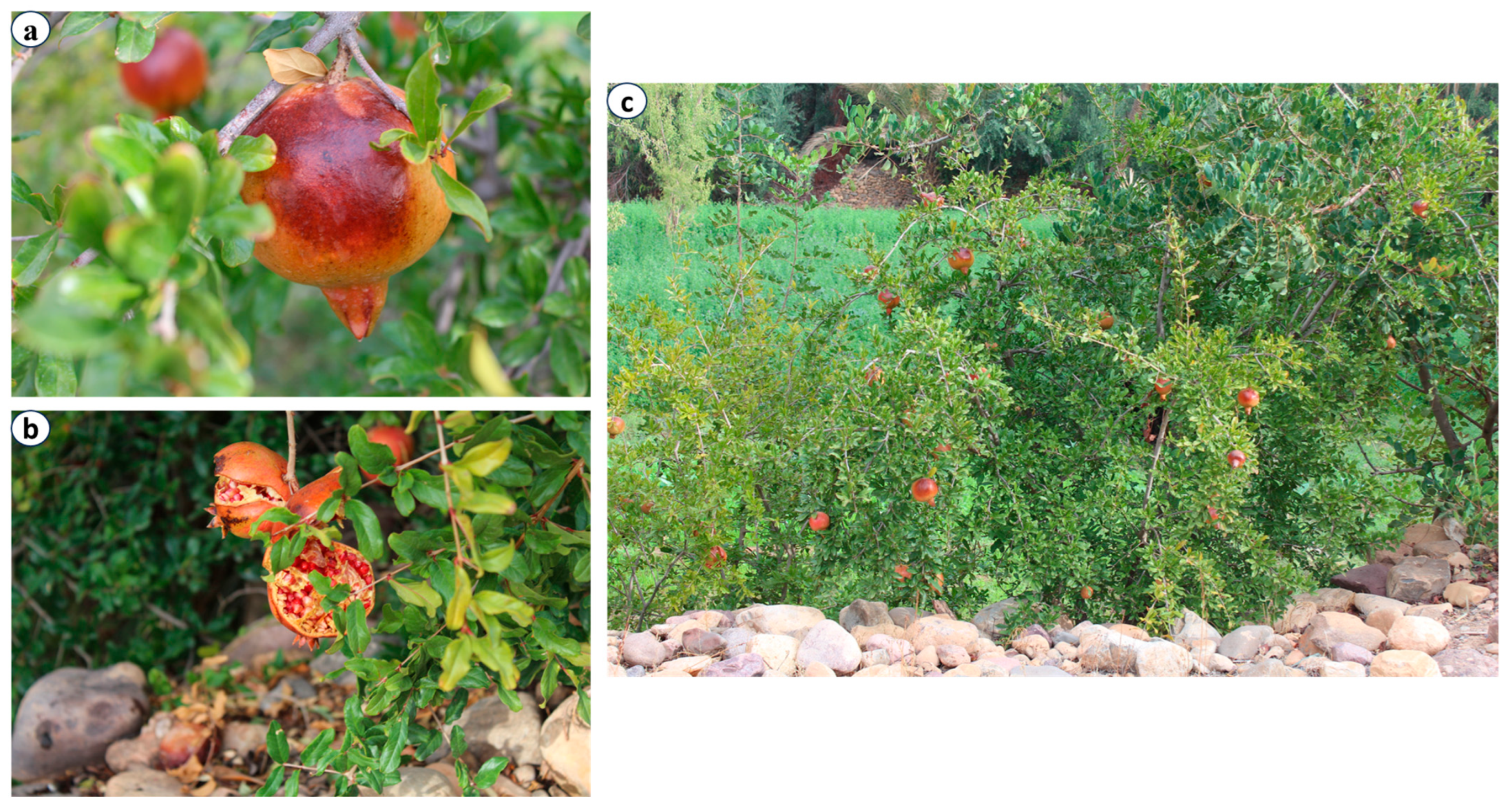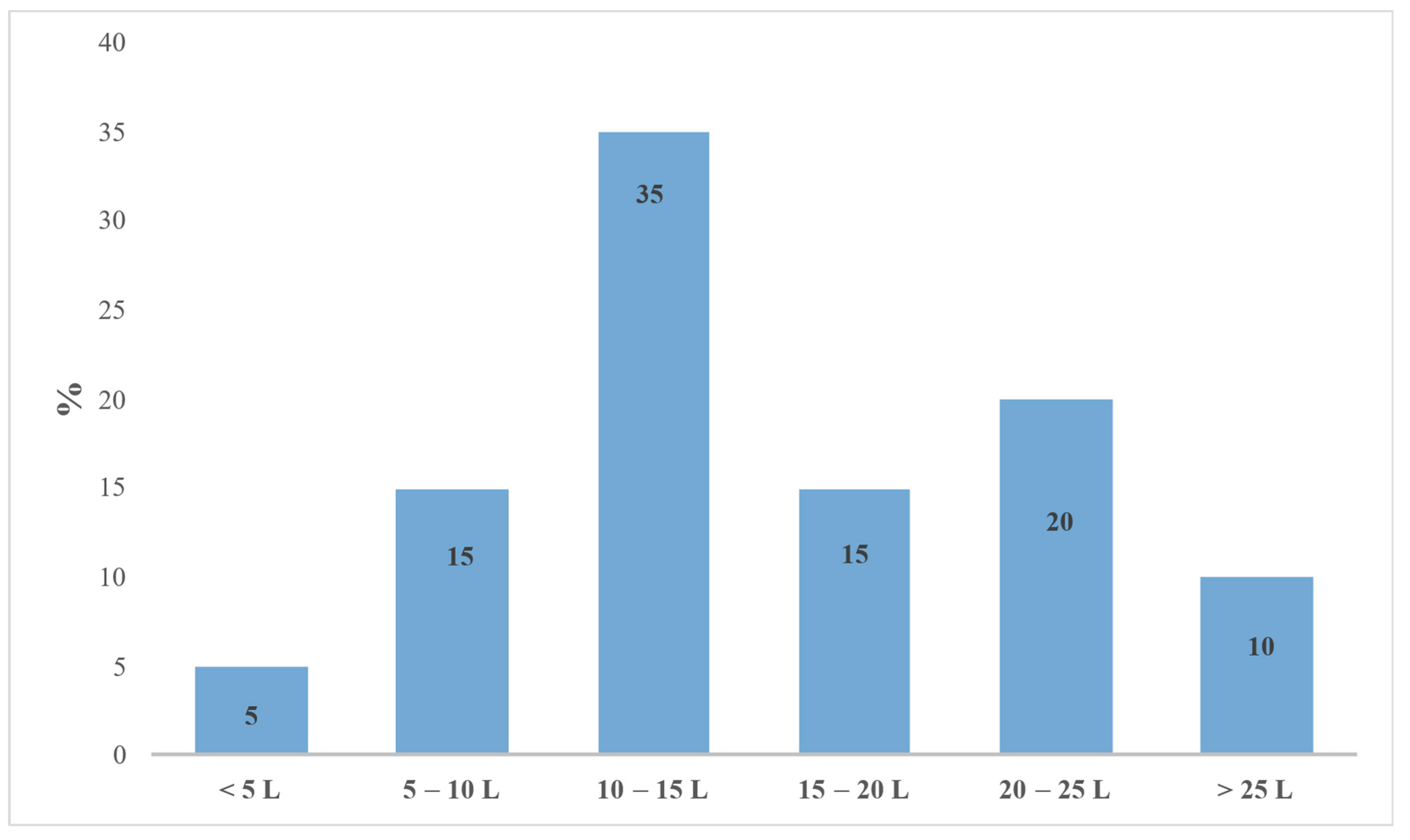Traditional Knowledge, Gendered Practices, and Agro-Biodiversity Conservation: A Case Study of Pomegranate in Moroccan Pre-Saharan Oases
Abstract
1. Introduction
2. Materials and Methods
2.1. Study Area
2.2. Data Collection
3. Results and Discussion
3.1. The Role of Pomegranate in Oasis Fruit Tree Agrobiodiversity
3.2. Special Case of the Guersmoum Variety
3.3. Amaghousse: A Traditional Distinctive Local Agri-Food Product
3.4. Uses and Commercialization of Amaghousse
3.5. Traditional Knowledge, Gender, and Biodiversity Conservation
4. Conclusions
Supplementary Materials
Author Contributions
Funding
Institutional Review Board Statement
Informed Consent Statement
Data Availability Statement
Acknowledgments
Conflicts of Interest
References
- Saad, A.B.; Abaab, A.; Bourbouze, A.; Elloumi, M.; Jouve, A.M.; Sghaier, M. La Privatisation des Terres Collectives dans les Régions Arides Tunisiennes: Contraintes Socio-Économiques et Impact Sur L’environnement; Foncier et Développement: Vergeze, France, 2010; 114p. [Google Scholar]
- De Grenade, R.; Nabhan, G.P. Agrobiodiversity in an oasis archipelago. J. Ethnobiol. 2013, 33, 203–236. [Google Scholar] [CrossRef]
- Leal Filho, W.; Stojanov, R.; Matsoukas, C.; Ingrosso, R.; Franke, J.A.; Pausata, F.S.; Harrouni, C. An Assessment of Climate Change Impacts on Oases in Northern Africa. Ecol. Indic. 2024, 166, 112287. [Google Scholar] [CrossRef]
- Battesti, V. Jardins au Désert: Évolution des Pratiques et Savoirs Oasiens: Jérid Tunisien; IRD Éditions: Paris, France, 2005. [Google Scholar]
- Bouaziz, A.; Hammani, A.; Kuper, M. Les Oasis en Afrique du Nord: Dynamiques territoriales et durabilité des systèmes de production agricole. Cah. Agric. 2018, 27, 14001. [Google Scholar] [CrossRef]
- Acherkouk, M.; Boughlala, M.; Kaci, S.; Omeiri, N.; Onana, C.; Rakotoson, S.R. Systèmes de Production Oasiens et Sylvo-Pastoraux: Interactions, Complémentarités et Développement Durable. Cas du Bassin de Ghéris (Maroc); Working Document Series; International Centre for Development Oriented Research in Agriculture: Montpellier, France, 2003. [Google Scholar]
- Houssni, M.; Kassout, J.; El Mahroussi, M.; Chakkour, S.; Kadiri, M.; Ater, M.; Petrisor, A.I. Evaluation and Structuring of Agrodiversity in Oases Agroecosystems of Southern Morocco. Agriculture 2023, 13, 1413. [Google Scholar] [CrossRef]
- Kradi, C. L’agriculture Solidaire dans les Éco-Systèmes Fragiles au Maroc; Institut National de la Recherche Agronomique: Rabat, Morocco, 2012. [Google Scholar]
- Houssni, M.; Kassout, J.; Ouahrani, A.E.; El Mahroussi, M.; Boselli, V.; Kadaoui, K.; Sahli, A.; Kadiri, M.; Ater, M. The conservation challenge of traditional agroecosystems in Morocco: The case study of six oases agroecosystems. In Climate Change Management; Springer: Berlin/Heidelberg, Germany, 2022; pp. 201–224. [Google Scholar]
- Houssni, M.; El Mahroussi, M.; Kassout, J.; Chakkour, S.; Sahli, A.; Kadaoui, K.; Ater, M. Reviving traditional know-how: A comprehensive analysis of date juice processing in Moroccan oases. Acta Bot. Hung. 2024, 66, 167–191. [Google Scholar] [CrossRef]
- Hmimsa, Y.; Aumeeruddy-Thomas, Y.; Ater, M. Une forme spontanée de figuier (Ficus carica L.), le nābūt. Rev. d’Ethnoécologie 2017, (Suppl. 1), 3186. [Google Scholar] [CrossRef]
- Bourguiba, H.; Audergon, J.M.; Krichen, L.; Trifi-Farah, N.; Mamouni, A.; Trabelsi, S.; Khadari, B. Genetic diversity and differentiation of grafted and seed propagated apricot (Prunus armeniaca L.) in the Maghreb region. Sci. Hortic. 2012, 142, 7–13. [Google Scholar] [CrossRef]
- Mamouni, A.; El Bakkali, A.; Lambert, P.; Krichen, L.; Oukabli, A.; Audergon, J.M.; Khadari, B. Bottleneck and gene flow effects impact the genetic structure of seed-propagated apricot populations in Moroccan oasis agroecosystems. Plant Genet. Resour. 2014, 12, 215–225. [Google Scholar] [CrossRef]
- Belarbi, A.; Bouayad, A.; Diaou, M.; Kaassis, N.; Tidjani Maliki, M. Agrobiodiversité et Durabilité des Systèmes de Production Oasiens dans la Palmeraie d’Aoufouss, Errachidia-Maroc; ICRA: Montpellier, France; INRA: Rabat, Morocco, 2004. [Google Scholar]
- Kassout, J.; Terral, J.F.; Boselli, V.A.; Souali, H.; Ater, M. Roots of Domestication: Unveiling the Dynamics of Domestication through Trait-Based Analysis of Olive Trees in Northern Morocco. Philos. Trans. B 2025, 380, 20240201. [Google Scholar] [CrossRef]
- IPCC. Climate Change 2014: Impacts, Adaptation, and Vulnerability; Contribution of Working Group II to the Fifth Assessment Report of the Intergovernmental Panel on Climate Change, Field, C.B., Barros, V.R., Dokken, D.J., Mach, K.J., Mastrandrea, M.D., Bilir, T.E., Chatterjee, M., Ebi, K.L., Estrada, Y.O., et al., Eds.; Cambridge University Press: Cambridge, UK, 2014. [Google Scholar] [CrossRef]
- Lionello, P.; Scarascia, L. The relation between climate change in the Mediterranean region and global warming. Reg. Environ. Change 2018, 18, 1481–1493. [Google Scholar] [CrossRef]
- Maffi, L. Biocultural diversity and sustainability. In The Sage Handbook of Environment and Society; Sage Publications: London, UK, 2007; pp. 267–278. [Google Scholar]
- Haddioui, A. La culture du grenadier (Punica granatum L.) au Maroc. In II International Symposium on the Pomegranate; CIHEAM/Universidad Miguel Hernández Zaragoza: Zaragoza, Spain, 2012; pp. 79–81. [Google Scholar]
- Ferrara, L.; Joksimovic, M.; D’Angelo, S. Effects of Punica granatum fruit (a super food) juice on human health. Curr. Nutr. Food Sci. 2022, 18, 618–628. [Google Scholar]
- Janick, J. The origins of fruits, fruit growing, and fruit breeding. Plant Breed. Rev. 2005, 25, 255–320. [Google Scholar]
- Hummer, K.E.; Pomper, K.W.; Postman, J.; Graham, C.J.; Stover, E.; Mercure, E.W.; Aradhya, M.; Crisosto, C.H.; Ferguson, L.; Thompson, M.M.; et al. Fruit breeding. In Emerging Fruit Crops; Springer: New York, NY, USA, 2012; pp. 97–147. [Google Scholar]
- Harlan, J.R. Origins and Processes of Grass Evolution and Domestication. In Grass Evolution and Domestication; Chapman, G.P., Ed.; Cambridge University Press: Cambridge, UK, 1992; pp. 159–175. [Google Scholar]
- Levin, G.M. Pomegranate Roads: A Soviet Botanist’s Exile from Eden; Pomegranate Roads: New York, NY, USA, 2006. [Google Scholar]
- Still, D.W. Pomegranates: A botanical perspective. In Pomegranates; CRC Press: Boca Raton, FL, USA, 2006; pp. 217–228. [Google Scholar]
- Spagnoli, F.; Shirazi, R.; Shirazi, Z.; Andam, S.S.G.; Djamali, M. Archaeology, history and symbolism. In The Pomegranate: Botany, Production and Uses; CAB International: Wallingford, UK, 2021; pp. 1–14. [Google Scholar]
- Bellakhdar, J. La Pharmacopée Marocaine Traditionnelle, 2nd ed.; Éditions Le Fennec: Casablanca, Morocco, 2020; Volume 2, pp. 1339–1370. [Google Scholar]
- Hammer, A.; Perrino, P. A Check-List of the Cultivated Plants of the Ghat Oases; De Gruyter Brill: Berlin, Germany, 1985. [Google Scholar]
- Allam, A.; Tirichine, A.; Cheloufi, H.; Arif, Y.; Tama, M.; Mimouni, A. Étude de la diversité biologique des espèces maraîchères cultivées dans les palmeraies de la vallée d’Oued Righ (Cas de la région de Tougourt). BioRessources 2013, 3, 64–71. [Google Scholar] [CrossRef]
- Benaoun, A.; Elbakkey, M.; Ferchichi, A. Change of oases farming systems and their effects on vegetable species diversity: Case of oasian agro-systems of Nefzaoua (South of Tunisia). Sci. Hortic. 2014, 180, 167–175. [Google Scholar] [CrossRef]
- Ministère des Affaires Locales et de l’Environnement (MALE). Inventaire Sommaire de l’Agrobiodiversité Dans les Oasis Tunisiennes (Régions de Gabès, Gafsa et Kébili); Projet « Gestion Durable des Écosystèmes Oasiens en Tunisie » (GDEO); Direction Générale de l’Environnement et de la Qualité de la Vie: Tunis, Tunisia, 2016; 194p, Available online: https://scid.tn/images/2020/document/inventaire_de_lagrobiodiversit_oasienne_Kbilli_gafsa_gabes.pdf (accessed on 5 August 2025).
- Aljane, F.; Elbekkay, M.; Neily, M.H.; Yahia, Y. Prospection et inventaire de l’agrodiversité dans les oasis traditionnelles de Zarat, Nouiel et El Guettar. Rev. Rég. Arides 2017, 43, 65–80. [Google Scholar]
- Chater, J.M.; Yavari, A.; Sarkhosh, A.; Jia, Z.; Merhaut, D.J.; Preece, J.E.; Hou, L. World pomegranate cultivars. In The Pomegranate: Botany, Production and Uses; CAB International: Wallingford, UK, 2021; pp. 157–195. [Google Scholar]
- Bennis, G.; Thenet, G. Une étude exploratoire du système de management de la performance immatérielle: Entre perceptions et pratiques. Manag. Avenir 2021, 124, 107–127. [Google Scholar] [CrossRef]
- Oukabli, A. Le grenadier: Des variétés performantes pour la culture. In Bulletin Mensuel d’Information et de Liaison du PNTTA; n°123; Transfert de Technologie en Agriculture, Ministère de l’Agriculture, du Développement Rural et des Pêches Maritimes: Rabat, Morocco, 2004. [Google Scholar]
- Jbir, R.; Melgarejo, P.; Hernández, F.; Haddioui, A.; Hannachi, A.S. Efficiency of inter simple sequence repeat (ISSR) markers for the assessment of genetic diversity of Moroccan pomegranate (Punica granatum L.) cultivars. Biochem. Syst. Ecol. 2014, 56, 24–31. [Google Scholar] [CrossRef]
- Ajal, E.A.; Jbir, R.; Legua, P.; Martinez, J.J.; Martinez, R.; Hannachi, A.S.; Haddioui, A. Genetic diversity of Moroccan pomegranate (Punica granatum L.) cultivars using AFLP markers. Aust. J. Crop Sci. 2015, 9, 22–29. [Google Scholar]
- Cossio, F.; Vitelli, V. Il Melograno: Botanica, Varietà, Impianto, Cure Colturali, Difesa e Utilizzi (Guida Illustrata); Supplemento a Vita in Campagna, 42; Edagricole: Bologna, Italy, 2018. [Google Scholar]
- Khadari, B.; Charafi, J.; Moukhli, A.; Ater, M. Substantial genetic diversity in cultivated Moroccan olive despite a single major cultivar: A paradoxical situation evidenced by the use of SSR loci. Tree Genet. Genomes 2008, 4, 213–221. [Google Scholar] [CrossRef]
- Achtak, H.; Ater, M.; Oukabli, A.; Santoni, S.; Kjellberg, F.; Khadari, B. Traditional agroecosystems as conservatories and incubators of cultivated plant varietal diversity: The case of fig (Ficus carica L.) in Morocco. BMC Plant Biol. 2010, 10, 28. [Google Scholar] [CrossRef]
- El Oualkadi, A.; Ater, M.; Messaoudi, Z.; El Heit, K.; Laucou, V.; Boursiquot, J.M.; Lacombe, T.; This, P. Genetic diversity of Moroccan grape accessions conserved ex situ compared to Maghreb and European gene pools. Tree Genet. Genomes 2011, 7, 1287–1298. [Google Scholar] [CrossRef]
- Legua, P.; Melgarejo, P.; Abdelmajid, H.; Martínez, J.J.; Martínez, R.; Ilham, H.; Hafida, H.; Hernández, F. Total phenols and antioxidant capacity in 10 Moroccan pomegranate varieties. J. Food Sci. 2012, 77, C115–C120. [Google Scholar] [CrossRef]
- Nasir, E.; Ali, S.I. Flora of West Pakistan; Fakhri Printing Press: Karachi, Pakistan, 1972. [Google Scholar]
- Evreinoff, V.A. Contribution à l’étude du grenadier. J. Agric. Trop. Bot. Appl. 1957, 4, 124–138. [Google Scholar] [CrossRef]
- Al-Said, F.A.; Opara, L.U.; Al-Yahyai, R.A. Physico-chemical and textural quality attributes of pomegranate cultivars (Punica granatum L.) grown in the Sultanate of Oman. J. Food Eng. 2009, 90, 129–134. [Google Scholar] [CrossRef]
- Burmistrov, L.A. Pomegranate culture in Central Asia. In Wanatca (West Australian Nut and Tree Crop Association) Yearbook; West Australian Nut and Tree Crop Association (Inc.): Subiaco, WA, Australia, 1993; Volume 17. [Google Scholar]
- Institut National de la Recherche Agronomique (INRA). Rapport D’activités 2011; INRA: Rabat, Morocco, 2011. [Google Scholar]
- Bourguiba, H.; Khadari, B.; Krichen, L.; Trifi-Farah, N.; Mamouni, A.; Trabelsi, S.; Audergon, J.M. Genetic relationships between local North African apricot (Prunus armeniaca L.) germplasm and recently introduced varieties. Sci. Hortic. 2013, 152, 61–69. [Google Scholar] [CrossRef]
- Narzary, Y.; Das, S.; Goyal, A.K.; Lam, S.S.; Sarma, H.; Sharma, D. Fermented fish products in South and Southeast Asian cuisine: Indigenous technology processes, nutrient composition, and cultural significance. J. Ethnic Foods 2021, 8, 33. [Google Scholar] [CrossRef]
- Musayev, M.; Huseynova, T. Collection, study and use of crop wild relatives of fruit plants in Azerbaijan. Int. J. Minor. Fruits Med. Aromat. Plants 2016, 2, 6. [Google Scholar]
- Khajebishak, Y.; Payahoo, L.; Alivand, M.; Alipour, B. Punicic acid: A potential compound of pomegranate seed oil in type 2 diabetes mellitus management. J. Cell. Physiol. 2019, 234, 2112–2120. [Google Scholar] [CrossRef]
- Banihani, S.; Swedan, S.; Alguraan, Z. Pomegranate and type 2 diabetes. Nutr. Res. 2013, 33, 341–348. [Google Scholar] [CrossRef] [PubMed]
- Khajebishak, Y.; Payahoo, L.; Alivand, M.; Hamishehkar, H.; Mobasseri, M.; Ebrahimzadeh, V.; Alipour, M.; Alipour, B. Effect of pomegranate seed oil supplementation on the GLUT-4 gene expression and glycemic control in obese people with type 2 diabetes: A randomized controlled clinical trial. J. Cell. Physiol. 2019, 234, 19621–19628. [Google Scholar] [CrossRef]
- Dargham, M.B.; Matar Boumosleh, J.; Farhat, A.; Bou-Maroun, E.; El Hosry, L. Antioxidant and anti-diabetic activities in commercial and homemade pomegranate molasses in Lebanon. Food Biosci. 2021, 41, 101052. [Google Scholar] [CrossRef]
- Aviram, M.; Dornfeld, L.; Kaplan, M. Pomegranate juice flavonoids inhibit low-density lipoprotein oxidation and cardiovascular diseases: Studies in atherosclerotic mice and in humans. Drugs Exp. Clin. Res. 2002, 28, 49–62. [Google Scholar] [PubMed]
- Neyrinck, A.M.; Van Hée, V.F.; Bindels, L.B.; De Backer, F.; Cani, P.D.; Delzenne, N.M. Polyphenol-rich extract of pomegranate peel alleviates tissue inflammation and hypercholesterolaemia in high-fat diet-induced obese mice: Potential implication of the gut microbiota. Br. J. Nutr. 2013, 109, 802–809. [Google Scholar] [CrossRef] [PubMed]
- Chalfoun-Mounayar, A.; Nemr, R.; Yared, P.; Khairallah, S.; Chahine, R. Antioxidant and weight loss effects of pomegranate molasses. J. Appl. Pharm. Sci. 2012, 2, 45–50. [Google Scholar]
- Khan, M.P.Z.; Ahmad, M. Traditional preference of wild edible fruits (WEFs) for digestive disorders (DDs) among the indigenous communities of Swat Valley-Pakistan. J. Ethnopharmacol. 2015, 174, 339–354. [Google Scholar] [CrossRef] [PubMed]
- Heywood, V.H. Use and Potential of Wild Plants in Farm Households; Food & Agriculture Organization: Rome, Italy, 1999; Volume 15. [Google Scholar]
- Powell, B.; Ouarghidi, A.; Johns, T.; Ibn Tattou, M.; Eyzaguirre, P. Wild leafy vegetable use and knowledge across multiple sites in Morocco: A case study for transmission of local knowledge. J. Ethnobiol. Ethnomed. 2014, 10, 34. [Google Scholar] [CrossRef]
- Molina, M.; Tardío, J.; Aceituno-Mata, L.; Morales, R.; Reyes-García, V.; Pardo de Santayana, M. Weeds and food diversity: Natural yield assessment and future alternatives for traditionally consumed wild vegetables. J. Ethnobiol. 2014, 34, 44–67. [Google Scholar] [CrossRef]
- Howard, P. Heritage: Management, Interpretation, Identity; A&C Black: London, UK, 2003. [Google Scholar]
- Howard, P.L. (Ed.) Women and Plants: Gender Relations in Biodiversity Management and Conservation; Zed Books: London, UK; New York, NY, USA, 2003; pp. 1–292. [Google Scholar]






Disclaimer/Publisher’s Note: The statements, opinions and data contained in all publications are solely those of the individual author(s) and contributor(s) and not of MDPI and/or the editor(s). MDPI and/or the editor(s) disclaim responsibility for any injury to people or property resulting from any ideas, methods, instructions or products referred to in the content. |
© 2025 by the authors. Licensee MDPI, Basel, Switzerland. This article is an open access article distributed under the terms and conditions of the Creative Commons Attribution (CC BY) license (https://creativecommons.org/licenses/by/4.0/).
Share and Cite
El Mahroussi, M.; Kassout, J.; Houssni, M.; Kadaoui, K.; Chakkour, S.; Sahli, A.; Boselli, V.A.; Hassan, B.; Ater, M. Traditional Knowledge, Gendered Practices, and Agro-Biodiversity Conservation: A Case Study of Pomegranate in Moroccan Pre-Saharan Oases. Conservation 2025, 5, 66. https://doi.org/10.3390/conservation5040066
El Mahroussi M, Kassout J, Houssni M, Kadaoui K, Chakkour S, Sahli A, Boselli VA, Hassan B, Ater M. Traditional Knowledge, Gendered Practices, and Agro-Biodiversity Conservation: A Case Study of Pomegranate in Moroccan Pre-Saharan Oases. Conservation. 2025; 5(4):66. https://doi.org/10.3390/conservation5040066
Chicago/Turabian StyleEl Mahroussi, Mohamed, Jalal Kassout, Mhammad Houssni, Khalil Kadaoui, Soufian Chakkour, Abdelouahab Sahli, Vladimiro Andrea Boselli, Bouziane Hassan, and Mohammed Ater. 2025. "Traditional Knowledge, Gendered Practices, and Agro-Biodiversity Conservation: A Case Study of Pomegranate in Moroccan Pre-Saharan Oases" Conservation 5, no. 4: 66. https://doi.org/10.3390/conservation5040066
APA StyleEl Mahroussi, M., Kassout, J., Houssni, M., Kadaoui, K., Chakkour, S., Sahli, A., Boselli, V. A., Hassan, B., & Ater, M. (2025). Traditional Knowledge, Gendered Practices, and Agro-Biodiversity Conservation: A Case Study of Pomegranate in Moroccan Pre-Saharan Oases. Conservation, 5(4), 66. https://doi.org/10.3390/conservation5040066





